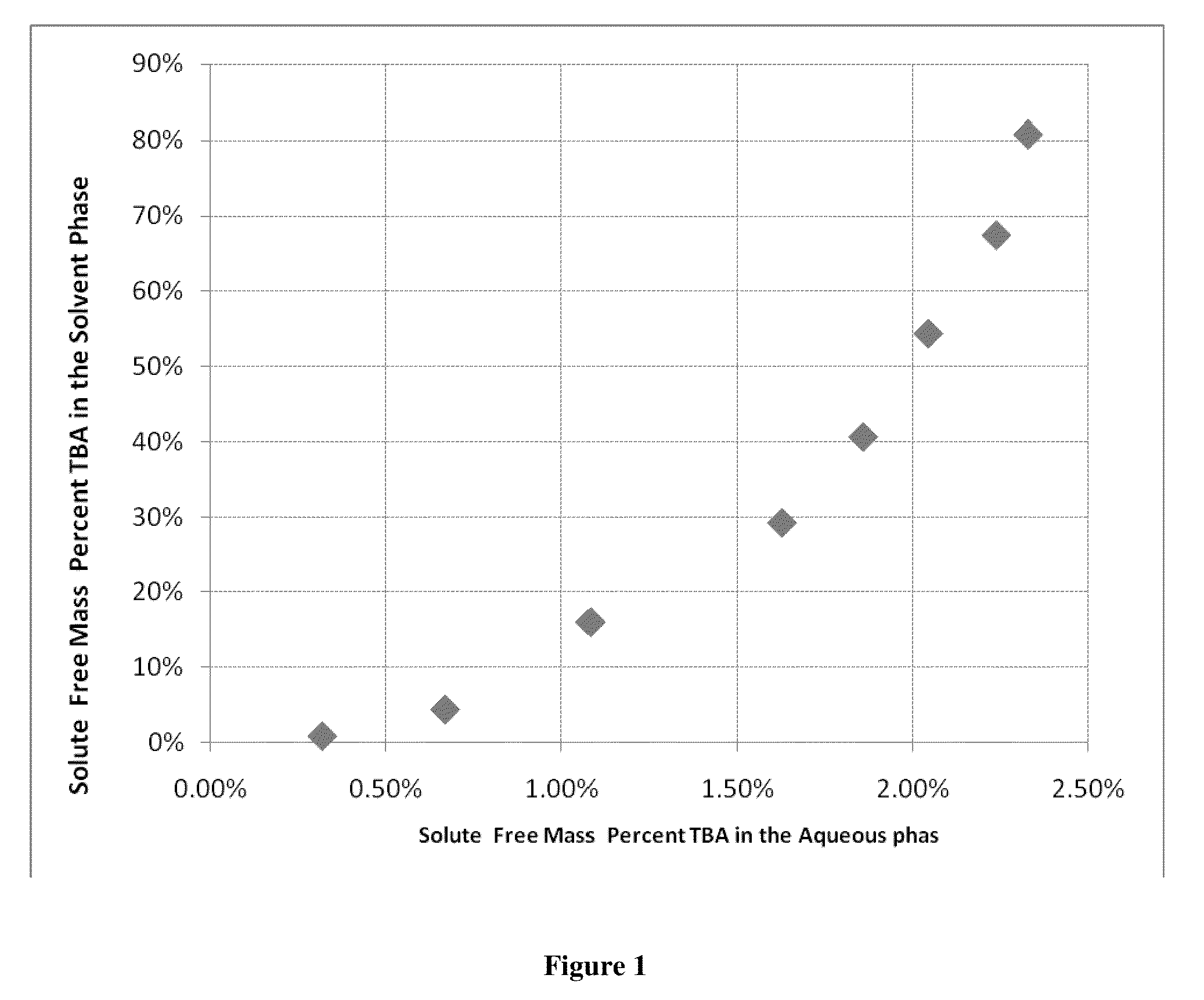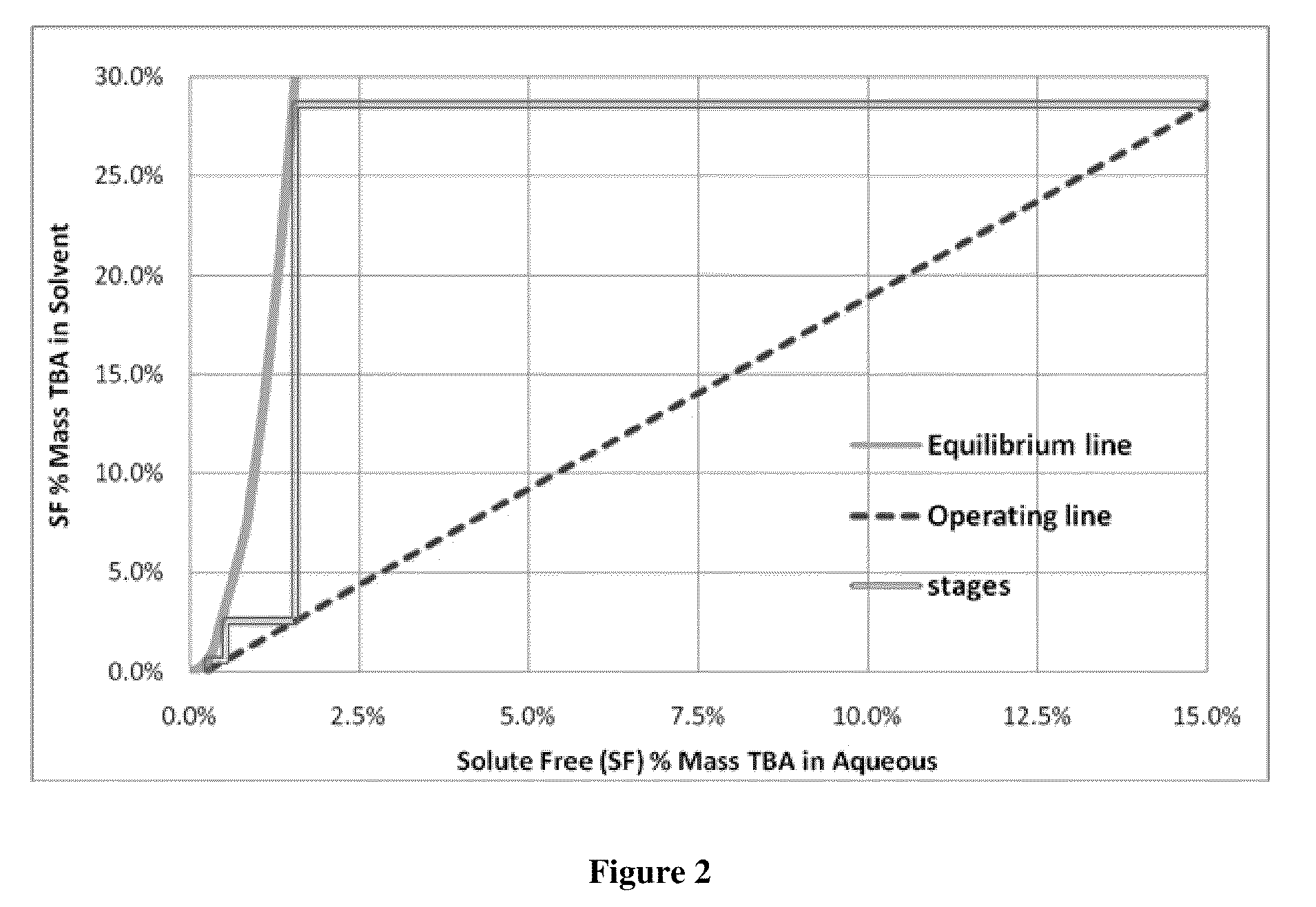Recovery of organic acids
a technology of organic acids and organic acids, applied in the field of organic acid recovery, can solve the problems of economic and environmental burden, failure to regenerate a free acid, and subsequent loss of tba, so as to improve the effective selectivity of solvents, improve the effect of energy saving and easy recovery
- Summary
- Abstract
- Description
- Claims
- Application Information
AI Technical Summary
Benefits of technology
Problems solved by technology
Method used
Image
Examples
example 1
[0048]This example illustrates that an amine, tributylamine (TBA), preferentially reports to the hydrocarbon phase in a two phase system of aqueous acetic acid / TBA complex and acetic acid solution and a normal hydrocarbon solvent of heptane.
[0049]1,750 mL of an aqueous feed of 5% by mass acetic acid stream was combined with 1,283 mL of heptane into a 2 gallon high-pressure agitated Parr reactor. This solution was then heated to 200° C. and agitated on high. When the desired temperature was reached, TBA was added to the system in discreet amounts of 14.93, 30.27, 96.98, 97.29, 97.09, 97.04, 97.21 and 97.4 gram additions. A high pressure piston driven chromatography pump (Eldex) was used to add the TBA into the pressure vessel when the vessel reached temperature and pressure. After each of these eight additions, the system was allowed to agitate on high for a time period of 30 minutes. After each agitation period, the system was allowed to settle and phase separate for five minutes. A...
example 2
[0053]This example illustrates that equilibrium of TBA complex and acid aqueous phase and organic phase containing TBA is reached quickly in a two phase system and that two different solvents, heptane and dodecane, have similar equilibrium curves.
[0054]Using the same apparatus as in Example 1, 1,400 mL of 5% by mass acetic acid stream was combined with 3,742 mL of dodecane in a 2 gallon agitated pressure vessel. This solution was heated to 200° C. A total of five TBA additions of 50, 150, 300, 400 and 600 grams of TBA were pumped into the mixing vessel. After each condition, time course samples were taken to determine if the mixture was at equilibrium. Additions were agitated on high for 1, 5 and 30 minutes. After each agitation period, the mixture was allowed to settle for five minutes before the sample was taken. For this experiment 50 mls of material was taken out to purge the sample tube before taking the 10 ml sample.
[0055]The results are shown graphically in FIG. 3. Very littl...
example 3
[0056]This example illustrates the effect of temperature on the equilibrium concentration of TBA in a two phase system of aqueous acetic acid / TBA complex and acetic acid solution and a normal hydrocarbon solvent of heptane.
[0057]1,750 mL of a 5% by mass acetic acid stream was brought into contact with 1,282 mL of heptane. The mixture was heated to 160° C. in the 2 gallon pressure reactor used in Example 1. Eight TBA additions were made in very nearly the same quantities as before in Example 1. The concentrations of TBA measured in the samples taken are shown in Table 2 below. A comparison of Example 1 and Example 3 illustrates the effect that temperature has on the concentration equilibrium curve of TBA in the two liquid phases, which is shown graphically in FIG. 4.
[0058]
TABLE 2g TBAMass TBAMass % TBAaddedAQ %Solvent15.40.40%0.8%30.071.05%6.3%97.251.78%13.7%97.152.56%23.0%97.073.07%30.6%97.173.21%37.8%97.393.61%44.3%97.183.99%50.3%
PUM
| Property | Measurement | Unit |
|---|---|---|
| temperatures | aaaaa | aaaaa |
| temperatures | aaaaa | aaaaa |
| temperatures | aaaaa | aaaaa |
Abstract
Description
Claims
Application Information
 Login to View More
Login to View More - R&D
- Intellectual Property
- Life Sciences
- Materials
- Tech Scout
- Unparalleled Data Quality
- Higher Quality Content
- 60% Fewer Hallucinations
Browse by: Latest US Patents, China's latest patents, Technical Efficacy Thesaurus, Application Domain, Technology Topic, Popular Technical Reports.
© 2025 PatSnap. All rights reserved.Legal|Privacy policy|Modern Slavery Act Transparency Statement|Sitemap|About US| Contact US: help@patsnap.com



